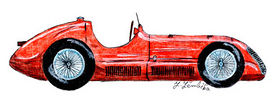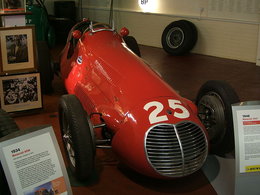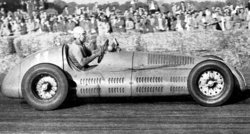Difference between revisions of "Maserati 4CL/50"
m |
m |
||
| Line 54: | Line 54: | ||
| Wins || 6 <small>(pre-war Voiturette)</small><br>25 <small>(post-war Grand Prix)</small><br>0 <small>(Formula One)</small> | | Wins || 6 <small>(pre-war Voiturette)</small><br>25 <small>(post-war Grand Prix)</small><br>0 <small>(Formula One)</small> | ||
|- | |- | ||
| − | |colspan=2 style="padding:0; background:#333333; color:#fff; border-bottom:1px solid #999;" |<videoflash> | + | |colspan=2 style="padding:0; background:#333333; color:#fff; border-bottom:1px solid #999;" |<videoflash>CUxjZY5ltJE|280|200</videoflash> |
|} | |} | ||
| Line 134: | Line 134: | ||
|- | |- | ||
| Wins || 18 <small>(post-war Grand Prix)</small><br>0 <small>(WC Formula One)</small><br>5 <small>(non-Champ F1)</small> | | Wins || 18 <small>(post-war Grand Prix)</small><br>0 <small>(WC Formula One)</small><br>5 <small>(non-Champ F1)</small> | ||
| + | |- | ||
| + | |colspan=2 style="padding:0; background:#333333; color:#fff; border-bottom:1px solid #999;" |<videoflash>CUxjZY5ltJE|280|200</videoflash> | ||
|} | |} | ||
Latest revision as of 18:24, 19 October 2009

| |
| Maserati 4CL | |
|---|---|
| Category | Voiturette |
| Constructor | Maserati |
| Designer | Ernesto Maserati |
| Team | Officine Alfieri Maserati Scuderia Platé Scuderia Milan Scuderia Ambrosiana |
| Drivers | |
| Chassis | Light alloy ladder |
| Front suspension | Independent, torsion springs and friction dampers |
| Rear suspension | Live axle, leaf springs and friction dampers |
| Wheelbase | 2500mm |
| Track | F: 1250mm R: 1276mm |
| Engine name | Maserati |
| Capacity | 1491cc-cu in |
| Configuration | straight-4 |
| Turbo/NA | single-stage supercharger |
| Engine position | front mounted |
| Gearbox name | Maserati |
| Gears | 4-speed |
| Type | manual |
| Differential | |
| Fuel | |
| Tyres | Pirelli |
| Debut | 1939 Tripoli Grand Prix |
| Races | |
| Wins | 6 (pre-war Voiturette) 25 (post-war Grand Prix) 0 (Formula One) |
The Maserati 4CL and its derived sister model the Maserati 4CLT are single-seat racing cars that were designed and built by Maserati. The 4CL was introduced at the beginning of the 1939 season, as a rival to the Alfa Romeo 158 and various ERA models in the voiturette class of international Grand Prix motor racing. Although racing ceased during World War II, the 4CL was one of the front running models at the resumption of racing in the late 1940s. Experiments with two-stage supercharging and tubular chassis construction eventually led to the introduction of the revised 4CLT model in 1948. The 4CLT was steadily upgraded and updated over the following two years, resulting in the ultimate 4CLT/50 model, introduced for the inaugural year of the Formula One World Championship in 1950. In the immediate post-war period, and the first two years of the Formula One category, the 4CLT was the car of choice for many privateer entrants, leading to numerous examples being involved in most races during this period.

The 4CL
Design
In the late 1930s, continued rapid development in the increasingly competitive international voiturette class, and the introduction of the Alfa Romeo 158 and ERA B- and C-type models, forced the Maserati brothers into designing a new, square-bore, inline-4 cylinder engine. This new engine developed 30-50bhp more than the previous inline-6, the increase mostly achieved through an increase to four valves per cylinder, coupled to the use of a more powerful supercharger and a small increase in the compression ratio. Following customary Maserati practice, the engine was mounted into a chassis design almost identical to that of the 4CL's predecessor: the Maserati 6CM. Conventional in its architecture, twin box-section spars ran the length of the car joined, ladder-fashion, by smaller cross members, although the 4CL design did incorporate more aluminium componentry than its forbear. Although near-identical in its wheelbase, the 4CL's track was a full 5cm wider than the 6CM, and sat lower thanks to repositioned spring hangers.
Enveloping this rather conservative chassis was a low, curvaceous alloy-panel body, built in-house by Maserati. Maserati also built a streamlined version of the 4CL from the outset. Continued engine development, in response to Alfa Romeo's post-war introduction of two-stage supercharging, began to expose weaknesses in the chassis design. In an attempt to improve torsional rigidity Maserati began to experiment with tubular section chassis members. These experimental models ran alongside conventional 4CLs throughout the 1947 season, and eventually led to the introduction of the 4CLT in 1948.
Race history
In the hands of Luigi Villoresi the streamliner took pole position on the 4CL's race debut at the 1939 Tripoli Grand Prix, ahead of Mercedes' brand new W165s. However, both it and two of the three conventional 4CLs entered retired early in the race with engine troubles, leaving the Silver Arrows to take the victory. Embarrassingly for the works team, following this disappointing debut the 4CL's first taste of victory came in the hands of privateer Johnnie Wakefield at the Naples Grand Prix, two races later. Through the remainder of 1939 voiturette races Wakefield took two further victories, and the works' 4CLs picked up another two, before the outbreak of war curtailed international competition. Villoresi took the 4CL to victory in the 1940 Targa Florio, but with entry restricted to Axis countries, and only Maserati fielding a factory team, the opposition was hardly World Class.
On the resumption of competition in 1946 the Maserati 4CL proved the class of the field. Luigi Villoresi immediately returned to winning ways, taking victory in the first race following the cessation of hostilities: the 1946 Nice Grand Prix. Tazio Nuvolari and Giorgio Pelassa both took wins in 4CLs, but it was Raymond Sommer and his 4CL who dominated the season. 1947 would prove to be the 4CL's most successful season and, despite Alfa Romeo fielding the revamped 158 and new 308, Maserati drivers picked up 10 individual race victories.
After the replacement of the factory team's 4CLs by the new 4CLT, many examples of the older cars found their way into privateer hands. It was owing to the 4CL's popularity with privateer entrants that many were still being run in top-flight competition at the outset of the Formula One World Championship in 1950.
The 4CLT
Chassis and engine changes made to the experimental 4CLs eventually coalesced into the 4CLT, the appended T denoting its tubular chassis. The improvements in torsional rigidity that the tubular construction brought were required to counteract the increases in torque and power resulting from the twin-supercharger upgrade of the elderly inline-4 engine. Power was up to approximately 260bhp, from the 4CL's 220. Other changes included the use of roller bearings for the crankshaft, forged (rather than cast) rear suspension components, and the chassis was designed to run with hydraulic dampers from the outset.

| |
| Maserati 4CLT | |
|---|---|
| Category | Voiturette / Formula One |
| Constructor | Maserati |
| Designer | Ernesto Maserati Alberto Massimino Vittorio Bellentani Arialdo Ruggieri |
| Team | Officine Alfieri Maserati Scuderia Platé Scuderia Ambrosiana Scuderia Achille Varzi Automovil Club Argentina Scuderia Milano |
| Drivers | |
| Chassis | Light alloy tubular ladder |
| Front suspension | Independent, coil springs and hydraulic dampers |
| Rear suspension | Live axle, leaf springs and hydraulic dampers |
| Wheelbase | 2500mm |
| Track | F: 1250mm R: 1200mm |
| Engine name | Maserati |
| Capacity | 1491cc |
| Configuration | straight-4, |
| Turbo/NA | two-stage supercharger, |
| Engine position | front mounted |
| Gearbox name | Maserati |
| Gears | 4-speed |
| Type | manual |
| Differential | |
| Fuel | |
| Tyres | Pirelli / Ernesto / Dunlop |
| Debut | 1948 Sanremo Grand Prix |
| Races | |
| Wins | 18 (post-war Grand Prix) 0 (WC Formula One) 5 (non-Champ F1) |
4CLT/48 Sanremo
The first variant of the 4CLT earned its nickname from the title of the first race for which it was entered: the 1948 Sanremo Grand Prix. The name stuck, as Alberto Ascari took his 4CLT to victory in its maiden race appearance. A portent of things to come, Villoresi and Reg Parnell won five of the 1948 season's remaining races. After the introduction of the modified 4CLT/49 chassis the following year, two of the remaining '48s were converted to 1720cc for the Temporada Formula Libre races in Buenos Aires, Argentina. In the first year of the Formula One World Championship, a '48 scored what was to be the Maserati's best Championship finish, when Louis Chiron took third place at his home Grand Prix: the 1950 Monaco Grand Prix. The last 4CL variant to compete in the World Championship was a 4CLT/48 modified by the Arzani-Volpini team, that failed to even qualify for the 1955 Italian Grand Prix.
4CLT/49
Minor modifications to the brake drums, switching from vanes to slits for cooling, along with small changes to the cockpit control layout and a repositioned oil header-tank resulted in a car sometimes referred to as the 4CLT/49. It was never known as such by the factory. The Ascari/Villoresi/Parnell trio, joined by Juan Manuel Fangio and Toulo de Graffenried, took up where they had left off the previous season, winning nine of the first fifteen races of 1949, including de Graffenried's victory in the British Grand Prix. However, the second half of the season only saw three further wins, as increasingly competitive Ferrari and Talbot cars squeezed out the Maseratis in most major races. A '49-spec 4CLT was modified by the Maserati factory to accept a more powerful OSCA V12 engine.
4CLT/50
1950 saw the introduction of the FIA Formula One World Championship. In response to improvements to the Alfa 158 and the already competitive Ferrari and Talbot, Maserati again upgraded the 4CLT's engine. A multi-part crankshaft, lightened and balanced rods, a more powerful pair of superchargers and changes to the ignition timing took engine output up to 280bhp. Coupled to shedding 10kg from the car's weight, this brought the Maserati up to near-Alfa levels of performance. Although moderately competitive in short runs, the final upgrades proved to be too much for the decade-old powerplant's design and the 4CLT/50's Grand Prix performance was hindered by engine failures. The season's only F1 wins came in non-Championship events. Fangio won at in Pau Grand Prix on the same day as Parnell took the Richmond Trophy at Goodwood, and David Hampshire won the Nottingham Trophy later in the year. Fangio also won the Formula 2 Ramparts Grand Prix at Angoulême, in a 4CLT chassis fitted with a A6GCM engine. The Milano team modified a '50 for use in 1950 and 1951, but without success.
The Platé 4CLT
A long term campaigner of Maserati automobiles, Enrico Platé recognised the Maserati's shortcomings as a Formula One vehicle, and converted a 4CLT/48 into the Maserati-Platé 4CLT Formula Two variant. As F2 was for naturally aspirated cars, the first step was to remove the superchargers. After this, to counteract the resulting loss in performance, the compression ratio was more than doubled and capacity was upped to the class limit of 2.0L. With the lower power output from the revised engine, weight was shed and handling sharpened by reducing the wheelbase.
Final race wins
De Graffenried won the Richmond Trophy, and Giuseppe Farina the Paris Grand Prix, in 1951, but with the switch to Formula Two rules for the World Championship from 1952 onwards, the old 4CLT chassis were found to be overweight and underpowered in comparison to their newer rivals. Despite having been the mainstay of top-flight racing since the end of the 1930s, the 4CL and 4CLT rapidly fell from favour, as smaller and lighter machines began to emerge from European factories still recovering from the effects of war.
Today, many 4CL and 4CLT models survive and are regularly campaigned in historic motorsport events, as well as being on static display in museums.
Maserati 4CM
1934 Maserati 4 CM 1500 Source
References
| Maserati | |
|---|---|
| 1950-1969 | A6 | 3500 | 5000 GT | Mistral | Quattroporte I | Sebring | Mexico | Ghibli I |
| 1970-1979 | Khamsin | Bora | Indy | Merak | Quattroporte II | Quattroporte III | Kyalami |
| 1980-1999 | Biturbo | Spyder I | Quattroporte III Royale | Shamal | 220 | 228 | 420 | 430 |Karif | Barchetta | Ghibli II | Quattroporte IV | 3200 GT |
| 2000-present | Coupé-Cabrio | Coupe | Spyder II | Gran Sport | Quattroporte V | MC12 | Gran Turismo |
| Racing Vehicles | 26M · 8C · V8RI · 8CM · 8CLT · 8CTF · 8CL · 6CM · 4CL/4CLT · A6GCM · 150S · Tipo 63 · Tipo 65 · 250F · 200S · 250S · 300S · 350S · 450S · Tipo 61 "Birdcage" · Tipo 151 · Tipo 154 · MC12 GT1 · Trofeo |
| Concept Cars | Boomerang · Birdcage 75th |
| Fiat Group brands | Abarth | Alfa Romeo | Autobianchi | Ferrari | Fiat | Lancia | Innocenti | Maserati |
| Alfa Romeo 158 • Alfa Romeo 159 • Alta GP • Cooper T12 • ERA A-type • ERA B-type • ERA E-type • Ferrari 125 • Ferrari 166 • Ferrari 275 • Ferrari 375 • Maserati 4CL • Maserati 4CLT • Milano • Simca-Gordini T15 • Talbot-Lago T26C/-DA/-GS | |
| Alfa Romeo 159/159A/159B/159M • Alta GP • BRM P15 • ERA B-type • Ferrari 125 • Ferrari 212 • Ferrari 375 • HWM • Maserati 4CL • Maserati 4CLT • OSCA 4500G • Simca-Gordini T11 • Simca-Gordini T15 • Talbot-Lago T26C/-DA/-GS • Thinwall Special • Veritas Meteor | |
| AFM • Alta F2 • Aston NB • BMW Eigenbau • Cisitalia D46 • Connaught Type A • Cooper T20 • ERA G-type • Ferrari 125 • Ferrari 166 • Ferrari 212 • Ferrari 500 • Frazer-Nash FN48 • Frazer-Nash 421 • Gordini T16 • HWM • Maserati 4CLT • Maserati A6GCM • OSCA 20 • Simca-Gordini T11 • Simca-Gordini T15 • Veritas Meteor • Veritas RS | |



